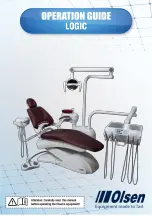
7
ENGLISH
OTOSCOPE
The Otoscope is designed to examine the external ear and for general non-invasive examination.
Features:
- Made from Impact Resistant re-enforced plastic and highly reliable corrosion resistant stainless steel.
- Easy replacement of lamp.
- Distal fibre optic illumination with super bright 3.5V Xenon/Halogen.
- Insufflation port pneumatic testing of tympanic mobility.
- Swivel type window with 3x Magnification lense for sharp images and minimal Reflection.
The Otoscope should only be used to examine the ear when a tip is fitted.
Pressure should be applied with great care when doing pneumatic testing.
OPERATING INSTRUCTION
Attach the otoscope head to the handle by bayonet locking system, it is necessary to hold the battery handle and
head in each hand and match the bayonet grooves on both the head and handle, push the head down and turn the
head clock wise as in Fig.1.
1. Check that the connection between the head and handle is perfect and that the rheostat works properly.
2. Push the button (F) on the handle and twist the black knob (G) towards the left hand side.
The unit is now in operating position. The intensity of the light can be adjusted by turning the knob clock wise or
counter clock wise.
3. Switch off the unit after use to preserve batteries. Twist the black knob towards right until an audible click sound is
heard once the button comes to its off position.
Attaching a tip
The Otoscope may only be inserted into the auditory canal when a disposable (grey) or reusable (black) tip is fitted.
Push the tip onto the instrument so that the internal projection engages in the slit (A) as in Fig.1. Twist to the right to
lock. Do not reuse the disposable speculum, because may cause patient-to-patient contamination.
Changing the lamp
With the Otoscope, first unlock the head from the handle and pull the lamp (D) downwards as in Fig.2. Push in the
new lamp.
Magnifying lens
The lens (B) has 3 x magnifications and can be swiveled aside for instrumentation.
Insufflations port
An insufflations bulb can be fitted to the port (C). A separately Insufflations bulb is used for pneumatic testing of
tympanic mobility.
General illumination:
The Otoscope can be used with or without a tip for general illumination of e.g. the oral cavity or skin. Avoid contact
with sensitive or damaged skin.
CLEANING AND STERILIZATION
Otoscope head
Clean the outside with a soft cloth, inside with a cotton wool bud, if necessary soaked in disinfectant or water.
Do not use rough cloth for cleaning the lens to avoid scratches.
Reusable Ear tips
These can be cleaned, disinfected or sterilized by any conventional method. Autoclaving is allowed. (121°C)
OPTHALMOSCOPE
The Opthalmoscope is designed for all general opthalmic examination.
























